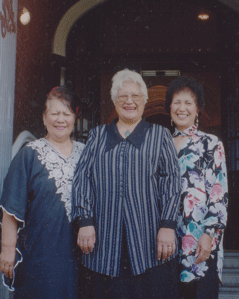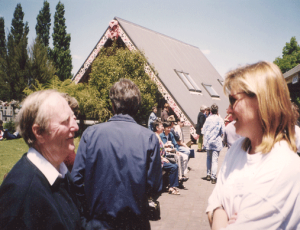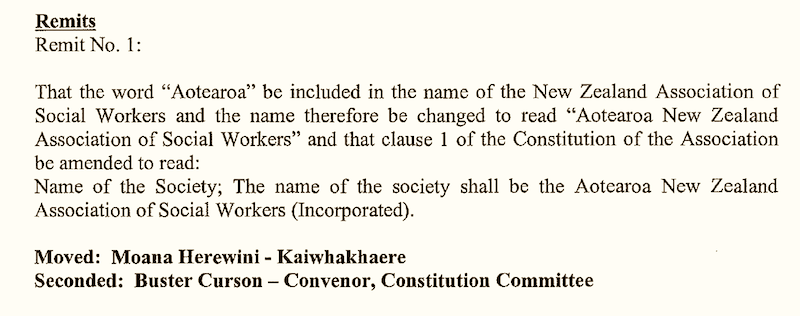Reflections on the fourth decade by Mary Nash
In writing this decade, I have included comments from members with good memories and some photos. I have also referenced useful websites. I have tried, as far as possible, to make sure the salient themes and issues of the decade are mentioned.
From an international perspective, the IFSW Secretariat moved to Berne: membership covered 84 countries, with almost 500,000 social workers. The book series “Social Work Around the World” was introduced in year 2000. Three core instruments were published: Definition of Social Work, Ethics and Global Standards for Social Work Education. ANZASW members Buster Curson and Fiona Robertson were elected to the IFSW executive, keeping Aotearoa New Zealand visible. The IFSW included in its published policies its International policy on women, building on the Platform for Action adopted in Beijing in 1995.
Meanwhile, closer to home, one can discern a struggle for hegemony over social work during this decade as practitioners tried to meet the conflicting demands of their profession and employers. Social work was in danger of fragmenting into a variety of agency-based tasks as it adapted to New Right policies (Cheyne et al 1997). In this respect, it could have risked losing its identity by neglecting its social justice and community development/social change responsibilities. An excellent source of items of interest during this decade is Mike O’Brien’s Social Policy and Social Work Digest, published in Social Work Review. It provides a picture of social work awareness of the widening poverty gap, the role of food banks, concern for the protection of human rights and information on statutory social service agencies.
In 1994, the Department of Social Welfare published Te Punga, the department’s response to Puao-Te-Ata-Tu. According to Cram (2012):
Māori were sceptical about Te Punga. For many Māori, Te Punga symbolised an anchor and the probability that the canoe of Puao-te-ata-tu would not be allowed to move anywhere. According to Taki (1996), Te Punga brought iwi to the realisation that the Crown would not deliver on its stated commitment to partnership with iwi or DSW’s endorsement of the principle of whakapakari whānau. (p.19)

In June 1995, the NZCETSS was formally disestablished and was replaced by Te Kaiawhina Ahumahi Industry Training Organisation for the Social Services. ANZASW was represented on the Board and various Committees until the ITO merged with Careerforce in 2011. One of its most significant contributions to social work were the National Guidelines for Accreditation and Course Approval for social service courses which it had launched in 1991, and which were received well by the social service sector. The provision of all levels of social and community work courses at university and other tertiary institutions increased during this decade, though the social work programme at Victoria University was disestablished. The ANZASW made submissions to the Vice-Chancellor of Victoria University to keep the social work programme, but in vain.
The ANZASW competency recertification programme was rolled out in 1995. The question of social worker registration has been a continuing feature in our Association publications, with some members in favour of promoting it, while others were more cautious. One particularly useful overview of the state of the debate was provided by Howard Randal (1997).

During the 1998 Conference at Kirikiriroa Marae, Hamilton, Harata Baucke was elected as President and Robyn Corrigan as Vice President of the Association. Kieran O’Donoghue recalls that: “Life memberships were awarded to John Bradley and Turoa Haronga. We had political speakers, Bob Simcock from the National Government, Minister of Social Services, Steve Maharey, Labour and James Ritchie. Issue 10 (4) of the Journal has a flavour of the conference in the editorial.
It was also the moment when the registration debate took impetus. From my perspective it reflected an impetus for biculturalism and Māori development within the Association, and professional regulation. And finally, it should be noted that I recall the wharenui being packed with people standing outside when Merv Hancock gave his paper on the social work profession in the next ten years.

In 1999, members of the ANZASW voted in favour of introducing a system of registration. Exactly what form members wished to see introduced was unclear. The campaign was taken up by the Department of Child, Youth and Family and supported by the Minister for Social Welfare.
In 2003, the Social Workers Registration Act came into law, but the title of social worker was not protected. The Act aims to protect the safety of members of the public by ensuring, through a system of registration, that social workers are accountable and competent to practice. The Social Workers Registration Board was appointed in accordance with the Act. The Board is a crown entity with accountability to the New Zealand public and the Government.
A summary of organisational changes to child welfare statutory provision from Department of Social Welfare to Ministry of Social Development during this decade is available on the Ministry of Social Development website:
In July 1998, the Department of Social Welfare comprised the Corporate Office and the business units of the Social Policy Agency (SPA), the New Zealand Community Funding Agency (NZCFA), the Children, Young Persons and Their Families Service (CYPFS), and Income Support. Since then, Income Support has moved to form the new Department of Work and Income (WINZ). The New Zealand Community Funding Agency (NZCFA) has integrated with CYPFS to form the Children, Young Persons and Their Families Agency (CYPFA). On 1 October 1999, CYPFA will become in its own right a stand alone Department of Child, Youth and Family Services (CYFS).
The remaining Corporate Office of the Department and SPA will integrate to form the Ministry of Social Policy. In December 1998, preliminary to establishing this Ministry, the housing policy function of the Ministry of Housing was transferred to SPA. This has enhanced the ability of the Agency to provide advice to the Government on a greater breadth of social policy on cross-sector issues.
The Strengthening Families strategy to child welfare was introduced including the Family Start programme, and in 1999, Child Youth and Family Services funded 12 pilot school social work projects and many school social work positions were subsequently created. Efforts at contracting partnerships with Iwi Social Services were important, but at times uneasy initiatives for CYFS to manage. Terms such as ‘moving from welfare to well-being’, and ‘giving a hand up, not a hand out’, were familiar catch-phrases of the decade.
References
Cram, F. (2012). Safety of subsequent children: Māori children and whānau. A review of selected literature. Wellington: Families Commission.
Randal, H. (1997). Competent practice and its regulation – debating the issues around the registration and professionalization of social work in New Zealand. Social Work Review. IX (1&2) pp. 16-19.
